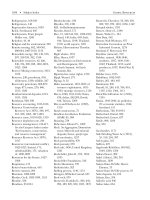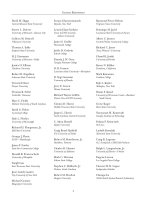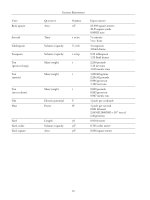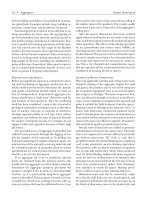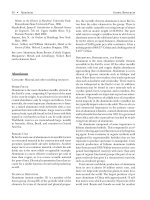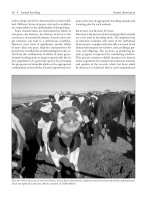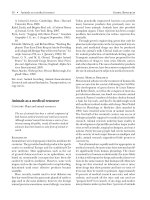Encyclopedia of Global Resources part 10 potx
Bạn đang xem bản rút gọn của tài liệu. Xem và tải ngay bản đầy đủ của tài liệu tại đây (384.43 KB, 10 trang )
The Country
Argentina is a wedge-shaped country at the tip of
South America. Physically, the nation has the largest
territory and fourth largest population—after Mex-
ico, Colombia, and Spain—of all Spanish-speaking
countries in the world. In total area, it is four times the
size of Texas and is the eighth largest country in the
world. Its capital, Buenos Aires, is the largest city in
the Southern Cone, which includes Argentina, Chile,
Paraguay, and Uruguay. Argentina’s annual gross do-
mestic product is consistently second in South Amer-
ica. Brazil, the largest country in the region, is always
first. Argentina clearly has great wealth and greater
economic potential owingtoitsnaturalresource base.
However, the top 1 percent of the people have nearly
all of the wealth and the bulk of the land, and the
national debt is high. Additionally, growing crops for
export and simultaneously producing food crops for
domestic consumption constitute a challenge for Ar-
gentina. As world food prices have escalated, export
critics have worried about Argentina’s ability to feed
its own people at affordable prices. Thus, Argentina
has natural resource problems for which the coun-
try’s diverse and educated people must eventually
find solutions.
Agricultural Land of the Pampas
Agricultural land composes47 percent of Argentina’s
total area, and agricultural products account for about
one-half the annual value of the country’s exports to
the global economy. The bulk of Argentina’s agricul-
tural exports come from the Pampas, which is the
wealthiest rural area in South America. The region’s
vast, open plains, deep, rich soil, and moderate cli-
mate are the physical bases for the wealth. The plains
topography is conducive to raising large fields of fod-
der crops for livestock yards and for open field graz-
ing. The climate of the Pampas area is much like that
of the Middle Atlantic states of the East Coast of the
United States. The Pampas has year-round precipita-
tion, a relatively longgrowing season, andmild winter
temperatures. The region’s best-known agricultural
exports are hides (for leather), beef, wool, and wheat.
However, its two most valuable commodities are ani-
mal feed (including unmilled cereals) and vegetable
fats, oils, and oil seeds, which come mostly from soy-
beans and sunflower seeds. Argentina’s main trading
partners for these products are China, India, Brazil,
and Chile.
In addition to the land’s natural resources, outside
influences were important in the development of Ar
-
gentina’sexporttrade.Duringthelate1800’s,inaddi-
tion to capitalandbusinessmethods,theBritishtrans-
planted technology that was especially suitable to the
Pampas’ windswept, grassy plains; the windmill and
barbed wire spurred the grazing and breeding of
high-quality beef cattle. Additionally, the British and
other foreign interests introduced refrigeration tech-
nology, an efficientrailroad network, seaport facilities
in Buenos Aires, and swift iron-hulled ships. As a re-
sult, Argentina was one of the leading agricultural ex-
porters in the world by the close of the nineteenth
century.
In the twenty-first century, the country ranksamong
the top-ten exporters in more than one dozen agricul-
tural categories. The “Wet Pampa,” the more humid
eastern part of the region, is more productive than
the “Dry Pampa” to the west. The Wet Pampa pro-
duces most of the nation’s exports, serving as the gra-
nary of South America, with soybeans, alfalfa, corn,
sunflowers, and flax as the principal crops. Neverthe-
less, experts have expressed concern about degrada-
tion of the soil in the Wet Pampa because of overuse
and abuse. The main crop in the Dry Pampa is wheat.
Cattle and sheep ranches exist throughout the Pam-
pas, especially in the southeast and north. The region
produces most of the beef and mutton that are ex-
ported from the country. Dairy products and vegeta-
bles, which are destined primarily for Argentine con-
sumers, are important near Buenos Aires.
Agricultural Land of the Interior
Argentines often describe their population as com-
posed of two groups, porteños and people of the inte-
rior. Porteños live in greater Buenos Aires, which corre-
sponds to the city of Buenos Aires and its intertwining
connections of highways, railroads, and cities in the
Pampas region. People of the interior live outside the
Pampas andare much morerural in theiroutlookand
economy.
The climate and soils of Argentina’s interior lands
vary from humid tropical and subtropical to desert
and mountain. The Paraná Plateau, which is north of
Buenos Aires, is the warmest and wettest part of the
country.Coffee, tea,andyerbamaté, a popular variety
of tea in Argentina and adjoining areas, are the re-
gion’s chief export crops.
The Mesopotamia lowland is just west of the pla
-
teau, where the Paraná and Uruguay rivers flow paral
-
lel to each other. The lowland has a subtropical cli
-
60 • Argentina Global Resources
Global Resources Argentina • 61
Argentina: Resources at a Glance
Official name: Argentine Republic
Government: Republic
Capital city: Buenos Aires
Area: 1,073,596 mi
2
; 2,780,400 km
2
Population (2009 est.): 40,913,584
Language: Spanish
Monetary unit: Argentine peso (ARS)
Economic summary:
GDP composition by sector (2008 est.): agriculture, 9.9%; industry, 32.7%; services, 57.4%
Natural resources: fertile plains of the Pampas, lead, zinc, tin, copper, iron ore, manganese, petroleum, uranium,
boron, bauxite, precious metals, lithium
Land use (2005): arable land, 10.03%; permanent crops, 0.36%; other, 89.61%
Industries: food processing, motor vehicles, consumer durables, textiles, chemicals and petrochemicals, printing,
metallurgy, steel
Agricultural products: sunflower seeds, lemons, soybeans, grapes, corn, tobacco, peanuts, tea, wheat, livestock
Exports (2008 est.): $70.59 billion
Commodities exported: soybeans and derivatives, petroleum and gas, boron, vehicles, corn, wheat
Imports (2008 est.): $54.55 billion
Commodities imported: machinery, motor vehicles, petroleum and natural gas, organic chemicals, plastics
Labor force (2008 est.): 16.27 million (urban areas only)
Labor force by occupation (2008 est.): agriculture, 1%; industry, 23%; services, 76%
Energy resources:
Electricity production (2006 est.): 109.4 billion kWh
Electricity consumption (2006 est.): 97.72 billion kWh
Electricity exports (2007 est.): 2.628 billion kWh
Electricity imports (2007 est.): 10.27 billion kWh
Natural gas production (2007 est.): 44.8 billion m
3
Natural gas consumption (2007 est.): 44.1 billion m
3
Natural gas exports (2007 est.): 2.6 billion m
3
Natural gas imports (2007 est.): 1.9 billion m
3
Natural gas proved reserves ( Jan. 2008 est.): 446 billion m
3
Oil production (2007 est.): 790,800 bbl/day
Oil imports (2005): 23,380 bbl/day
Oil proved reserves ( Jan. 2008 est.): 2.186 billion bbl
Source: Data from The World Factbook 2009. Washington, D.C.: Central Intelligence Agency, 2009.
Notes: Data are the most recent tracked by the CIA. Values are given in U.S. dollars. Abbreviations: bbl/day = barrels per day;
GDP = gross domestic product; km
2
= square kilometers; kWh = kilowatt-hours; m
3
= cubic meters; mi
2
= square miles.
Buenos Aires
Argentina
Bolivia
Brazil
Chile
Paraguay
Uruguay
Falkland
Islands
Atlantic
Ocean
Pacific
Ocean
mate and exports spices (pepper, cumin, turmeric,
nutmeg, cinnamon, and ginger), tobacco, citrus, and
cattle.
The semiarid Gran Chaco, which sits immediately
west of Mesopotamia,exports some live cattle,cotton,
and oil crops, especially peanuts and sunflower seeds.
Still farther west is the Dry Chaco, which is truly a
desert because it is in the rain shadow of high summits
of the Andes Mountains. Nevertheless, the Gran
Chaco’s fertile valley oases in the states of Jujuy, Salta,
Tucumán, San Juan, and Mendoza export several
products, including sugar, grape juice, fruits, and
corn. Wine from these valleys, in particular, has gained
popularity in the U.S. market. Livestock husbandry,
especially of cattle and sheep, has been important
also.
Patagonia is the final agricultural region that con-
tributes to the nation’s export economy. Sheep ranch-
ing (chiefly for wool) is a principal product of the re-
gion. The poor soils of Patagonia and its cool and dry
climate limit crop production.
Petroleum and Natural Gas
Oil and petroleum-related products and natural gas
make up Argentina’s second most valuable category
of exports. Together, they amount to about 15 per-
cent of the total value of the country’s exports. The
main recipients are Chile, the United States, Brazil,
and China, in that order. Most of Argentina’s produc
-
tion of these two products takes place in Patagonia,
the country’s largest state, in the Neuquén and the As-
tral basins at the base of the Andes. Neuquén ac-
counts for the bulk of the national production. Other
long-standing producing basins are the Cuyo, San
Jorge, and Magallenes. From 1980 to 2010, national
gas production more than quadrupled.
Argentina is not a world leader in oil and gas ex-
ports, but it plays a relatively significant role supplying
these products to its South American neighbors. The
country was thesecond largest exporter ofnatural gas
in South America in 2008. Only Bolivia exported
more. In that year, Argentina ranked fourth in the ex-
portation of petroleum in the South America region,
behind Venezuela, Brazil, and Ecuador, in decreasing
order. Argentina’s natural gas and petroleum exports
are relatively important to the region, but Venezuela
and Bolivia exceed Argentina by far in terms of totals
for both resources in productionandproved reserves.
In 2008, the leading producing company in the coun-
try was YPF S.A., followed by Pan American Energy
LLC, Petrobrás Energía S.A., and Chevron Argentina
S.R.L., in decreasing order.
Copper, Gold, and Silver
Economists and geologists classify gold and silver as
precious metals because of their relatively high value
per unitofweight. In contrast, owingtothe bulk of im
-
purities of copper ore, copper is considered an indus
-
62 • Argentina Global Resources
A soybean farmer in the Pampas region of Argentina inspects his harvest. (Andres Stapff/Reuters/Landov)
trial mineral or nonprecious metal. Argentina’s pro
-
duction of copper, gold, and silver has increased
rapidly. Ores of all three metals can form in similar
geological environments. For example, all three are
hidden beneath the dryhillsofthePuna regionin the
country’s northwest corner. The Puna also produces
small amounts of tin, lead, zinc, and ferrous minerals.
The grassy knolls of Argentina’s north-central region
have gold and porphyry copper, but also small
amounts of nickel-platinum and manganese. One-
third of the mining is done inPatagonia, whichmakes
up the southern third of the country. Scattered in the
region are large epithermal gold and silver deposits as
well as polymetallic lead-zinc deposits. The lastsetting
is the magnificent Andes Mountains region, which
has deposits of porphyry copper and gold as well as
chromium. The Andes region is where most of Argen-
tina’s mining takes place, although explorations by
mining companies have indicated that great potential
exists for expanded mining in the other three re-
gions. Mineral exploration has increased because of
direct foreign investment ventures by Canadian, Chi-
nese, U.S., and British companies, in decreasing or-
der of investment.
Together, copper and gold accounted for about 75
percent of the annual value of all mining in the coun-
try in2006, but copper is byfar the more important of
the two minerals.Copper accounted for 98 percent of
value of all nonprecious metal ores that were mined
and exported from the country that year. However,
gold exports rose rapidly after the opening of the
Veladero Mine in 2006. Catamarca is the leading pro-
ducing province for gold, most of which comes from
the Bajo de la Alumbrera Mine. San Juan Province,
where theVeladero Mine islocated,isthe number-two
producer. Other producing provinces are Santa Cruz
and La Rioja. Most of the gold produced in Santa
Cruz is from the Cerro Vanguardia Mine. A small
amount of gold is from the Martha Mine in La Rioja.
Argentina is the fourth-largest producer of silver in
Latin America. In 2006, the leading recipients of Ar-
gentina’s metallic ores were Germany, Spain, South
Korea, India, and Brazil.
Aluminum and Water Power
The manufacture of aluminum requires the raw ma-
terial alumina and massive amounts of electricity.
Argentina’s alumina comes from smelting bauxite
(alumina ore), which the country imports. Hydro
-
electricity is a necessary power source because it can
be produced more cheaply than electricity generated
by burning expensive fossil fuels. The refining of alu-
mina is the last step in aluminum production, which
begins with exploratory drilling to locate the ore,
then removing overburden through blasting and the
use of giant earthmoving equipment.
Aluar Aluminio Argentino S.A.I.C., or Aluar, is Ar-
gentina’s only producer of aluminum. The company is
a privately owned stock-trading company that controls
every aspect of the aluminum business. It converts
alumina to primary aluminum and aluminum prod-
ucts for use in transportation, construction, electrical,
medical, water treatment, and packaging industries.
Aluar generates its own electricity at its dam on the
Futaleufú River in the Andes Mountains. The com-
pany transfers the electricity via its own power lines to
its aluminum factory near Puerto Madryn in Chubut
Province. The company’s energy consumption has ex-
ceeded its capacity for generating hydroelectricity, so
it has supplemented its needs with electricity from
burning natural gas, an abundant and a relatively low-
cost power source in Argentina. Morethan80percent
of Aluar’s production is exported to other countries.
The products include aluminum bars, tubes, and pro-
files (flat-angle shapes) in a variety of sizes and forms.
Other productsincludesheetmetal and rolls inawide
range of alloys for multiple uses, including foil for dis-
posable food containers and for packaging tobacco,
pills, food, and other consumer items. The primary
importers are the United States, Japan, Chile, Brazil,
and Mexico.
Boron
Argentina was the world’s third largest exporter of bo-
ron in 2006. Turkey and the United States were first
and second, respectively. In thatyear,thecountry pro-
duced 15 percent of the total world supply. Boron is
processed from borate ore, which formed in ancient
lake beds at different times. The Puna region, which
includes the northwestern corner of Argentina and
adjoining areas in Bolivia and Chile, is the main area
of borate deposits in South America. The oldest de-
posits in Argentina formed from 6 to 1.5 million years
ago. The Puna is in the high desert of Salta Province,
about 4,000 meters above sea level. The main pro-
ducer of boron in thisarea is Salta Mining and Energy
Resources, an Argentine company. Borax, an Ameri-
can company, mines boron in the Loma Blanca area
southeast of thePunaregion. Most of Argentina’s pro
-
duction is exported to South American customers.
Global Resources Argentina • 63
Boron-based compounds are used in the manufac
-
ture of such items as boric acid, cosmetics, soaps and
detergents, flame retardants, glazes on ceramics, fi-
berglass, and glass fibers.
Lithium
In 2006, Argentina produced 12 percent of the total
world production of lithium. Lithium is a rare earth
mineral that forms during mountain building, when
igneous activities enrich lithium-bearing oresinsilicic
and pegmatite rocks. The weathered products of these
rocks are the most economical sources of lithium;
they appear as lithium carbonate and lithium chlo-
ride in rare brine deposits of ancient lake beds. Lith-
ium-bearing deposits are in northwestern Argentina,
in the Puna, Loma Blanca, and Salar de Hombre
Muerto areas. The lithium division of the FMC Corpo-
ration, an international and publicly traded company,
established the first and largest commercially viable
lithium-mining operation at Salar deHombre Muerto.
That mine produces lithium chloride from the brine
of the salar (salt flat) using a patented ionic exchange
process.
Refined lithium is used in the manufacture of ce-
ramics, glass, batteries, lubricating greases, pharma-
ceuticals and polymers, air-conditioning, and primary
aluminum production. Lithium use in batteries has
expanded significantly because such batteries have a
much longer lifetime than ordinary batteries do. As a
result, lithium batteries have been used increasingly
in portable electronic devices, such aslaptop comput-
ers, and in home fire alarms and electrical tools. The
greatest potential market is in batteries for plug-in hy-
brid vehicles. The potential market in the United
States expanded significantly when General Motors
announced it would introduce a line of hybrid vehi-
cles in late 2009. Argentina’s northwest could see
greater mining of lithium, as the mineral has increas-
ingly become a strategicmaterialfor its projected role
in helping alleviate the automobile’s reliance on fossil
fuels.
Other Resources
Argentina is one of six Latin American exporters of
lead and zinc, ranking second to Mexico in lead.
Other metallic ores that are mined commercially in-
clude nickel, manganese, chromium, titanium, and
molybdenum. The country’s marine resources also
enter the global economy, as Argentine fishing com
-
panies catch crustaceans and shellfish that they ex
-
port primarily to Spain, Italy, Brazil, and France,inde
-
scending order. A fair amount of agricultural land,
which is a natural resource that depends on local cli-
mate and soil fertility, is planted with feed crops that
support the production of dairy products and eggs to
Algeria, Venezuela, Brazil, and Chile. Additional Ar-
gentine exports are timber products (logs, lumber,
and pulpwood), mainly to Brazil, South Africa, and
France.
Richard A. Crooker
Further Reading
Arnold, Guy. The Resources of the Third World. New York:
Cassell, 1997.
Crooker, Richard A. Argentina. Edgemont, Pa.: Chel-
sea House, 2004.
Foster, David William, Melissa Fitch Lockhart, and
Darrell B. Lockhart. Culture and Customs of Argen-
tina. Westport, Conn.: Greenwood Press, 1998.
Garrett, Donald E. Borates: Handbook of Deposits, Pro-
cessing, Properties, and Use. San Diego: Academic
Press, 1998.
Kogel, Jessica Elzea, et al., eds. Industrial Minerals and
Rocks: Commodities, Markets, and Uses. 7th ed. Little-
ton, Colo.: Society for Mining, Metallurgy, and Ex-
ploration, 2006.
Lewis, Daniel K. The History of Argentina. Westport,
Conn.: Greenwood Press, 2001.
Rotolo, G. C.,etal. “Energy Evaluation of Grazing Cat-
tle in Argentina’s Pampas.” Agriculture, Ecosystems,
and Environment119,no. 3 (March, 2007):383-395.
Web Sites
Central Intelligence Agency
The World Fact Book
/>world-factbook/index.html
Food and Agriculture Organization of the
United Nations
Country Profiles
/>International Trade Centre
Countries
/>U.S. Geological Survey
Aluminum
/>commodity/aluminum/myb1-2006-alumi.pdf
64 • Argentina Global Resources
U.S. Geological Survey
Boron
/>commodity/boron/boronmcs07.pdf
U.S. Geological Survey
Lithium
/>commodity/lithium/lithimcs07.pdf
U.S. Geological Survey
2006 Minerals Yearbook, Argentina
/>2006/myb3-2006-ar.pdf
World Bank
/>See also: Agricultural products; Agriculture indus-
try; Aluminum; Boron; Farmland; Forests; Lithium;
Oil and natural gas distribution.
Army Corps of Engineers, U.S.
Category: Organizations, agencies, and programs
Date: Established 1802
The U.S. Army Corps of Engineers has historically
been one of the most important government agencies
affecting the development, use, and conservation of
natural resources, especially water resources. Since its
founding in 1802, the organization has engaged in a
multitude of civil and military activities. It has some-
times been in conflict with other agencies with overlap-
ping responsibilities.
Background
The U.S. Army Corps of Engineers was established by
an act ofCongress on March 16, 1802.This legislation
stationed thegroupat WestPoint,NewYork,where, in
addition to performing work on coastal defenses, it
was to operate a military academy that would train
critically needed engineers.
Impact on Resource Use
The U.S. Army Corps of Engineers’ relationship to
natural resources, particularly water resources, came
into focus gradually. One important statement of na
-
tional responsibility concerning water came in 1824
when the Supreme Court ruled that the federal gov
-
ernment had broad interstate commerce regulatory
power, covering river navigation. Following thisCourt
decision, Congress gave the Corps of Engineers im-
portant responsibilities relating to the development
of civil works. During this period, and for a long time
thereafter, natural resources were seen as virtually in-
exhaustible, and the emphasis was overwhelmingly
on development, not on conservation.
The General Survey Act of 1824 seemed to repre-
sent a commitment to engage in professional and sys-
tematic national planning for resource development.
However, this was not to bethe case. Congress, operat-
ing according to procedures that encouraged indi-
vidual congressional members to promote localized
projects of benefit to their particular constituencies,
essentially converted the Corps of Engineers into a
tool for spending sizable amounts of federal moneyin
congressional members’ own states and districts. The
funds were spent on river and harbor improvements
and on roads. Sometimes the engineers lobbied Con-
gress for permission to participate in projects in which
they were especially interested. Corps activities re-
lated to canal-building were most visible. Construc-
tion of large and increasingly controversial waterways
continued until the late twentieth century.
By the late twentieth century, support for costly
public works projects was far less than it had once
been. For fiscal as well as environmental reasons, ap-
proval for such projects became more difficult than
had been the case previously. An important piece of
legislation bearing on the missions of the U.S. Army
Corps of Engineers was the Water Resources Develop-
ment Act of 1986. It states explicitly that environmen-
tal factors are crucial in all planning related to water
resources. All projects are subject to modification to
produce environmental benefits. The Corps became
committed to an enlightened handling of environ-
mental concerns and to safeguarding as well as devel-
oping natural resources. When the problem of water
pollution first began to be perceived as an important
area of government concern, the Army Corps of Engi-
neers’ position typically was that the problem should
be handled at state and local levels. Later, however,
the Corps considered its antipollution activities to be
among its most important responsibilities.
The Corps started promoting flood control in the
years following the Civil War. Not until 1936 did Con-
gress officially state that flood control was a legitimate
federal function. The Corps played an important role
in the building of levees affecting the hurricane-
Global Resources Army Corps of Engineers, U.S. • 65
ravaged coastal regions of the states adjacent to the
Gulf of Mexico. The Corps has also developed ways
for many areas throughout the country to obtain
water, and many communities draw their water from
Corps projects.
William H. Stewart
Web Site
U.S. Army Corps of Engineers
/>See also: Bureau of Land Management, U.S.; Bureau
of Reclamation, U.S.; Dams; Environmental move-
ment; Floods and flood control.
Arsenic
Category: Mineral and other nonliving resources
Where Found
Elemental arsenic is occasionally found in minerals,
but more frequently it is combined chemically with
sulfur, either alone or with metals such as copper,
nickel, cobalt, or iron. China istheworld’s largest pro-
ducer of elemental arsenic. Because of the health
risks of arsenic, there has been no U.S. production of
arsenic trioxide or arsenic metal since 1985.
Primary Uses
Wood preservatives, herbicides, and insecticides are
major uses of arsenic chemicals. Arsenic is used to
harden lead alloys for battery plates, solder, and lead
shot, while arsenides of gallium and indium have uses
in lasers, light-emitting diodes, and transistors. In the
United States, approximately 4 percent of arsenic
(measured in metric tons of arsenic content) goes to
agricultural chemicals, 3 percent to glass products, 3
percent to nonferrous alloys and electronics, and 90
percent to pressure-treated wood. The electronics
industry uses a very pure form of arsenic in gallium-
arsenide semiconductors for solar cells, space re-
search, and telecommunications.
Technical Definition
Arsenic (abbreviated As), atomic number 33, belongs
to Group V of the periodictableoftheelementsandis
classified as a metalloid, rather than a metal or non
-
metal. There is only one naturally occurring isotope,
with an atomic weight of 74.93. Elemental arsenic ex
-
hibits gray, yellow, and black forms with densities of
5.73, 1.97, and 4.73 grams per cubic centimeter. The
common gray form sublimes when heatedto613°Cel-
sius and melts under a pressure of 28 atmospheres
(2.8 million pascals) at 817° Celsius.
Description, Distribution, and Forms
Arsenic is widely distributed and is found in soils and
seawater in trace amounts: 1 to 40 parts per million in
soil, and 2 to 5parts per billion in seawater. It averages
about 1.8 parts per million by weight. The most abun-
dant arsenic mineral is arsenical pyrite (also called ar-
senopyrite or mispickel), asulfideof iron and arsenic.
Other significant ores are arsenolite (arsenious ox-
ide), orpiment (As
2
S
3
), and realgar (As
4
S
4
). Seawater
averages 0.5 to 2 parts per billion of arsenate, but
lakes and streams often have higher concentrations;
these vary from one body of water to another. Lake
Michigan, for example, has levels of 0.5 to 2.4 parts
per billion. Fishandshellfishhave arsenic levels about
one thousand times greater than seawater and much
higher than federal drinking water standards (0.05
part per million). Arsenobetaine, with a formula of
(+)(CH
3
)3As-CH
2
-CO
2
(−), is common in fish, and
many other methylated compounds are found in ma-
rine organisms.
Arsenic toxicity is highly dependent on the state of
chemical combination of the element. Elemental ar-
senic is less toxic than combined forms; the most dan-
gerous forms are arsine, arsenites, and arsenious ox-
ide. Ingestion of as little as 0.1 gram of arsenious
oxide has caused death. Methylated compounds such
as arsenobetaine are much less toxic.
Arsenic intoxication symptoms include skin rashes,
anemia, gastrointestinal distress, internal bleeding,
and shock. Chronic poisoning can result in a gangre-
nous condition of the feet (“blackfoot disease”), and
the action of arsenic as a carcinogen and teratogen
has been established. Paradoxically, arsenic, like sele-
nium, is an essential trace nutrient for some species.
The toxicity of arsenic is only partly understood, par-
ticularly its carcenogenicity. Arsenate, AsO
4
(3−), be-
cause of its similarity to phosphate, can react with
adenosine, leading to uncoupling of oxidative phos-
phorylation, an important energy-producing system
in plants and animals. Arsenite, AsO
3
(3−), inhibits
many enzymes by binding to thiol (−SH) groups that
exist, for example, in pyruvate oxidase. The vital
tricarboxylic acid cycle is thereby disrupted. Admin
-
66 • Arsenic Global Resources
istration of antidotes such as penicillamine or dimer-
captopropanol that contain −SH groups will bind
preferentially to the arsenite and keep it from the en-
zymes. Ingested arsenic tends to accumulate in the
hair and can be detected by neutron activation analy-
sis. Atomic absorption spectroscopy can also detect
and measure trace amounts of arsenic.
History
Arsenic was known in early times in India, Persia, and
Mesopotamia, and it is mentioned in the writings of
Aristotle, Hippocrates, and Pliny the Elder. These an-
cient writings are often vague and do not allow the
modern reader to decide exactly whether elemental
arsenic or some compound such asanoxideorsulfide
is described. European alchemists such as Albertus
Magnus (thirteenth century) and Johannes Schröder
(seventeenth century) published procedures for pre-
paring arsenic from orpiment (As
2
S
3
) or arsenious ox
-
ide (As
2
O
3
), but priority in discovery is considered un
-
certain.
The toxic characteristics of arsenious oxide were
noticed long ago, and the substance became notori-
ous in varioushomicidal poisoning cases. TheRoman
emperor Nero,forexample,poisonedhis own brother.
Accidental arsenic poisoning is exemplified by the
events reported in 1973 in Pelham, Minnesota, where
a well had been drilled on land that had received
heavy dosages of arsenic insecticides.
In spite of the danger, pigments containing arsenic
were still used in cakes and candy in the nineteenth
century, and arsenic-containing medicines of dubi-
ous value were used in the early twentieth century. Ar-
senicals are still occasionally used to treat stubborn
parasitic diseases (trypanosomiasis, amoebiasis).
Obtaining Arsenic
There are more than two hundred recognized ar-
senic-containing minerals. Arsenic is leached into
water by weathering of rocks and is distributed by vol
-
canic action. In the soil, microorganisms can metabo
-
lize arsenate or arsenite, producing a variety of or
-
Global Resources Arsenic • 67
Data from the U.S. Geological Survey, . U.S. Government Printing Office, 2009.Source: Mineral Commodity Summaries, 2009
1,000
11,500
25,000
1,500
1,500
7,000
4,000
1,500
500
Metric Tons
30,00025,00020,00015,00010,0005,000
Russia
Mexico
Kazakhstan
China
Chile
Belgium
Morocco
Peru
Other countries
Arsenic Trioxide: World Production, 2008
ganic methylated compounds that find their way into
water and into the bodies of all sorts of marine crea-
tures. An estimated 40,000 metric tons of arsenic are
added to the world’s oceans annually byweatheringof
rocks, as compared with world industrial production
of 55,000 to 70,000 metric tons per year.
Human activity accounts for significant releases of
arsenic into the air, water, and soil. Smelters emit ar-
senic oxide dust, and herbicides and insecticides re-
main in the soil. One of the large smelters in the
United States (nolonger operating) emitted 181 met-
ric tons of arsenious oxide per year into the area sur-
rounding Tacoma, Washington.
Uses of Arsenic
Production of arsenic has ceased in the United States,
and uses are subject to increasingly severe regulation.
Nevertheless, the United States still imports about sev-
eral thousand metric tons per year, mainly for wood
preservation and pesticide uses.
John R. Phillips
Further Reading
Adriano, DomyC.“Arsenic.”In Trace Elements inTerres-
trial Environments: Biogeochemistry, Bioavailability,
and RisksofMetals. 2d ed. NewYork:Springer,2001.
Fowler, Bruce A., ed. Biological and Environmental Ef-
fects of Arsenic. New York: Elsevier, 1983.
Greenwood, N. N., and A. Earnshaw. “Arsenic, Anti-
mony, and Bismuth.” In Chemistry of the Elements.2d
ed. Boston: Butterworth-Heinemann, 1997.
Henderson, William. “The Group 15 (Pnictogen) Ele-
ments: Nitrogen, Phosphorus, Arsenic, Antimony,
and Bismuth.” In Main Group Chemistry. Cam-
bridge, England:RoyalSociety of Chemistry,2000.
Massey, A. G. “Group 15: The Pnictides—Nitrogen,
Phosphorus, Arsenic, Antimony, and Bismuth.” In
Main GroupChemistry.2ded. New York: Wiley,2000.
Naidu, Ravi, et al., eds. Managing Arsenic inthe Environ-
ment: From Soil to Human Health. Enfield, N.H.: Sci-
ence Publishers, 2006.
Ng, J., ed. Arsenic and Arsenic Compounds.2ded.
Geneva, Switzerland: World Health Organization,
2001.
Nriagu, Jerome O., ed. Arsenic in the Environment.2
vols. New York: Wiley, 1994.
Ravenscroft, Peter, Hugh Brammer, and Keith Rich-
ards. Arsenic Pollution: A Global Synthesis. Malden,
Mass.: Wiley-Blackwell, 2009.
Thayer, John S. Environmental Chemistry of the Heavy El
-
ements: Hydrido and Organo Compounds. New York:
VCH, 1995.
Web Sites
Health Canada
Healthy Living: Arsenic in Drinking Water
/>arsenic-eng.php
U.S. Environmental Protection Agency
Arsenic in Drinking Water
/>U.S. Geological Survey
Arsenic: Statistics and Information
/>commodity/arsenic
U.S. Geological Survey
Arsenic in Ground Water of the United States
/>See also: Bronze; China; Gallium; Herbicides; Mining
wastes and mine reclamation; Native elements.
Asbestos
Category: Mineral and other nonliving resources
Where Found
Asbestos-form mineralsare common in metamorphic
rocks all over the world, but the great majority of the
world’s production has come from only two types of
deposits. Themostimportantofthese, represented by
major deposits inCanadaandRussia,are produced by
metamorphic alteration of alpine-type ultramafic
rocks—dark-colored, high-density igneous rocks low
in silica andhigh in iron and magnesium.The second
major type of deposit, much less important than the
first, is produced by the metamorphism of layered
ultramafic intrusions. Important deposits of this type
occur in Africa.
Primary Uses
The major use in the world market is in the manufac-
turing of asbestos-cement products. Other important
uses are in friction products, such as clutch facings
and brake linings, and in roofing products. Asbestos
with particularly long fibers is spun into cloth and
68 • Asbestos Global Resources
used to manufacture fire-resistant conveyor belts,
safety clothing, and other types of fireproof textiles,
such as curtains and blankets.
Technical Definition
There are six different minerals that have been pro-
duced as asbestos. By far the most important one, ac-
counting for approximately 95 percent of the world
production and consumption, is chrysotile, or “white
asbestos,” a fibrous form of the serpentine group of
minerals. The serpentinesare hydrous magnesiumsil-
icates with a layered structure. Commercial depos-
its of chrysotile occur in ultramafic rocks, particu-
larly peridotite, that have undergonemetamorphism.
The five other forms of asbestos are members of the
amphibole group of minerals. In order of impor-
tance, these are crocidolite (“blue asbestos”), amosite
(“brown asbestos”), anthophyllite, tremolite, and ac-
tinolite. The amphiboles are silicates with a chainlike
structure and an extremely variable composition.
Description, Distribution, and Forms
Asbestos is not a mineral or a rock; rather, it is an in-
dustrial term used to refertoa few minerals that some-
times occur in a fibrous form. Asbestos refers to a few
types of minerals that sometimes occur as long, slen-
der fibers. It is this fibrous nature that accounts for
both the usefulness and hazards of asbestos. Asbestos
minerals differ from one another in many ways, but
they share great resistance to heat, chemical attack,
and friction. These properties make asbestos an im-
portant industrial commodity. The major asbestos de-
posits of the world are located in Canada, China, Rus-
sia, Kazakhstan, and some African countries. The
Thetford District in the eastern townships of Quebec,
Canada, and the Bazhenov area in the Ural Moun-
tains of south-central Russia and Kazakhstan have
been the most productive sites for asbestos. Thetford
production has been continuous since 1878. The de-
posits in the Urals have not operated as long but are
thought to have the greatest reserves in the world.
The geology of both of these two great districts is simi-
lar. Chrysotile occurs as veins and fissures in ultra-
mafic rock that has undergone metamorphism dur-
ing mountain-building events. The Ural deposits have
the greater tonnage of production, but the Thetford
deposits are of a higher grade and produce more
long-fiber asbestos. African production includes both
chrysotile and amphibole asbestos (amosite and cro
-
cidolite) and comes from Zimbabwe, South Africa,
and Swaziland. Zimbabweanproduction is minor com
-
pared to those of Russia, China, and Kazakhstan,
whose combined output accounted for approximately
73 percent of the world’s total production of approxi-
mately 2.2millionmetrictons in 2007. Thisfigure rep-
resents a decline of about one-third from the early
1970’s. The rate of decline has leveled off from the
late 1980’s but is projected to continue because of op-
position to the use of asbestos in building and con-
sumer products. Decline in production in the United
States was sharper, falling by more than 90 percent
from the early 1970’s to the end of the 1990’s. The
United States ceased production of asbestos in 2002.
History
The ancient Romans were the first to use asbestos.
They wove it into aclothanduseditin cremations and
for permanent lamp wicks. Knowledge of asbestos
seems to have been lost after the Romans until it was
rediscovered in Italy in 1868. The development of as-
bestos as an important industrial mineral began with
the opening of the world’s first great deposit in east-
ern Quebec, Canada, in 1878.
Obtaining Asbestos
Fibers with alength-to-width ratio greater than 50 to 1
command the highest price becausethey canbemixed
Global Resources Asbestos • 69
Anthophyllite is one of six minerals that are classified as asbestos.
(USGS)
